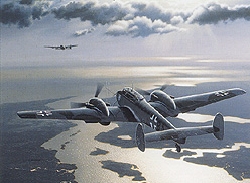|
|
| Top Night Fighter |
|
 |

|
 |
|
|
| DESCRIPTION |
 |
| 16 x 11.5 Inch Collector Size Unframed Lithograph $40.00
Major Heinz Schnaufer, with 121 victories, was the top-scoring night fighter ace of all time. He became a Luftwaffe pilot in 1942 and obtained his first victory in June of that year. By August his victory count had reached twenty-two and he was put in command of the 9th Staffel of the IV/BJG1. On the evening of December 16, 1943 Schnaufer downed four RAF Lancaster 4-engine bombers, and on February 21, 1945 he claimed a total of nine Lancasters in one evening. He received the highest award which could be obtained, the "Diamonds" to the Knights Cross, upon attainment of his 100th victory. Schnaufer survived the War, but was killed in a motoring accident in 1950. As depicted by Stan Stokes in his dramatic painting entitled Top Night Fighter, Schnaufer, who primarily flew the night fighter version of the Messerschmitt Bf-110 "Zerstorer," homes in on an RAF Lancaster heavy bomber. The Bf-110 grew out of Herman Goring's specifications for a multipurpose aircraft capable of penetrating deep into enemy airspace to clear the sky of enemy fighters in advance of German bomber formations. The aircraft would also be utilized as a long range interceptor, and as a ground support and ground attack bomber. The Bf-110 prototype first flew in 1936. The prototype was under powered with its Daimier Benz DB 600A engines. Several months passed before a go ahead was given for large scale production which commenced in 1938. Utilizing improved DB 601 engines, the early production 110s were as fast as any single engine fighter at that time, and had superior fire power. Their biggest apparent weakness was in the areas of armor protection for the crew, and in terms of maneuverability when compared to single seat fighters. The 110 was produced in large numbers and in many different variants. The 110D was the long range model. An additional belly tank was fitted to that aircraft, with several later variants having the more traditional drop tanks. The first serious test for the Bf-110 came during the Battle of Britain. About 300 Bf-110s were involved. They became easy prey for Hurricane and Spitfire pilots, and Bf-109s were often required to assist the 110s in their own defense. On August 15, 1940, which became known as Black Tuesday, the Bf-110s were ravaged by the RAF, and for the month over 100 aircraft were lost. On the Eastern Front the Bf-110 performed admirably in the early stages of Operation Barbarossa. With the Soviet Air Force weakened in the first several weeks of the attack, 110s were effectively utilized in a ground attack role. Ultimately, the Luftwaffe re-equipped a significant number of its 110s as night fighters. The aircraft performed well in this role because it was a good gun platform with sufficient speed to overtake the RAF night bombers. Such night missions were typically carried out with no Allied fighter escort, so the 110 night fighters would not have to engage or elude Allied fighters in this role. |
|


|